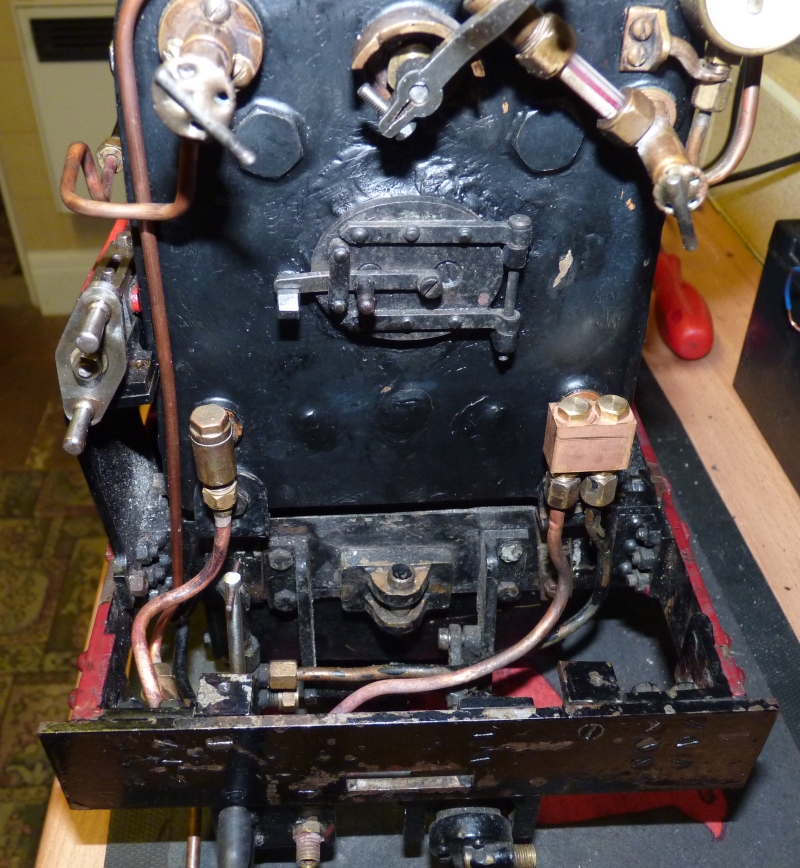|
|
Post by tomtomgo on Apr 7, 2024 21:44:36 GMT
Interested in opinions of proposed setup of a boiler having two clack valves where both axle and hand pump share one clack and the steam injector uses the other clack.
Should the axle and hand pump have separate clack valves?
|
|
uuu
Elder Statesman
   your message here...
your message here...
Posts: 2,856
|
Post by uuu on Apr 8, 2024 7:12:55 GMT
Ideally separate - when shared each pump will rely on the others valves to prevent back-flow. So when one pump fails, the other can become ineffective too. But I've seen it done. So I've the boiler is not yet made, I'd add an extra bush - but no point trying to retro-fit one. I've also seen two clacks side-by-side screwed into a single boiler bush - borrowing a John Baguley picture here:  Wilf |
|
oldnorton
Statesman
  5" gauge LMS enthusiast
5" gauge LMS enthusiast
Posts: 720
|
Post by oldnorton on Apr 8, 2024 9:28:21 GMT
Your axle pump will have two ball valves, inlet and exit. Similarly the hand pump has the two ball valves. The outlet from each of those pumps can be tee'd together as neither can send its flow back through the outlet of the other. Even if one ball failed or leaked there is a second ball in line. In theory, this common, tee'd pipe, could be connected directly to a boiler without a clack and it would work. But that is not good practice and a boiler mounted clack would be used as well. I therefore offer another option to wilf's and suggest that it is not essential to have the axle pump and hand pump each feeding their own, separate boiler clacks.
Having the injector on its own boiler mounted clack is necessary as it does not have any internal non-return balls.
|
|
uuu
Elder Statesman
   your message here...
your message here...
Posts: 2,856
|
Post by uuu on Apr 8, 2024 10:03:09 GMT
Just another thought in support of separate feeds (although as OldNorton says, shared axle/hand pump feed will work):
Boiler feed issues are infuriating. Six people will gather round and each will have a different idea as to the cause. Diagnosis is much easier if you can halve the number of areas to investigate.
Wilf
|
|
|
|
Post by tomtomgo on Apr 8, 2024 18:30:35 GMT
Thank you for your responses.
|
|
|
|
Post by John Baguley on Apr 12, 2024 8:46:59 GMT
There are several 2½" Gauge designs that have the handpump feeding through the axle pump into a single clack and using that as the only boiler feed. It's open to debate whether that is classed as two separate feeds or only one as there is only one boiler clack. I know a friend had problems getting his loco tested at his club as the boiler inspector insisted that the boiler had to have two separate clacks. No problem if you have another feed by an injector etc. as well.
The big downside to having the handpump feeding through the axle pump is that you have to remember to shut the bypass valve whenever you want to use the handpump. The number of times I have been furiously pumping away with the handpump and wondered why the water level in the boiler wasn't going up!
John
|
|
|
|
Post by jo479 on Apr 15, 2024 17:58:10 GMT
As UUU says, individual feeds and Clacks are much easier to fault find, I drove a Royal Scot one day with everything feeding through one clack valve, I was struggling to put water in and couldn't isolate the cause, never again/
|
|
|
|
Post by tomtomgo on Apr 15, 2024 18:06:23 GMT
And the type of clack valves used is relevant? For example, can shuttle type O ring valves be used for both injectors as well as axle and hand pumps?
|
|
uuu
Elder Statesman
   your message here...
your message here...
Posts: 2,856
|
Post by uuu on Apr 15, 2024 18:35:07 GMT
And...
I have wondered on my own loco (Ken Swan's Jessie) why the clacks for axle pump and injector are different. The injector one uses a 3/16" ball and the pump has 1/4". So - if you use O-ring valves, should they also be of different sizes?
Wilf
|
|